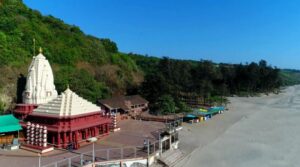
Ganpatipule is a small town located in the Ratnagiri district on the Konkan coast of Maharashtra. The Swayambhu Ganpati Temple, on the Ganapatipule beach is the primary attraction that draws thousands of pilgrims every year to this village. Its origin can be imagined by its references in ancient literatures like Mudgal-puran etc, where it has been referred to as the “Paschim Dwar- Devata”or “Paschim Dwarpalak” (Western Sentinel God) and those visiting Ganpatipule make it a point to pay their respect to this deity.
Legends
During the reign of Muguls there was a ‘kevada’ (Flower) forest at the foot of the hill where the temple of ‘Swayambhu’ Ganapati is presently situated. Here lived Balbhatji Bhide, a brahmin, who was renter of the village. During the moghul period, Bhide encountered a major personal problem. Bhide being a determined person that he was, made up his mind to give up food and water till being relieved of personal calamity. He stayed in the Kevada forest for penance and worship his tutelary deity ‘mangalmurti’ (Lord Ganesh).
During this period, Bhide had a vision about Lord Ganesh who said, ” I have come to Aagargule (Ganesh Gule) to fulfil the wishes of my devotees. The hill is my ‘nirakar’ from (Void from) you worship and propitiate here, and will be relieved of all your difficulties”.
During the same period, one of the cows of Bhide was not giving milk, for which reason, the cowherd kept a close watch on her. He was astonished to see that the milk was flowing from cow’s udder on the place where the idol of the God is placed at present. The cowherd narrated the incident to Bhide. On Cleaning up the entire area Bhide found the idol of Ganesh which he had seen in his vision He built a shrine here and started performing rituals.
According to another local folklore, the Hindu god Ganapati, taking umbrage at a remark made by a native lady, moved to Pulé (a few km before the town) from his original abode of Gulé. Thus the region was named Ganpati-pulé.
While some people believe that Ganpatipule got this name from the white sand (Pule in Marathi) from which the idol of Lord Ganesh was crafted.
The 400-year-old Ganpati idol at Ganpatipule is said to have sprung up from the soil. This deity faces the west, so as to guard the western gates, unlike deities in other Indian temples who face the east. The temple is at the base of a hill, and pilgrims walk around (pradakshina) the hill as a mark of respect.
The mesmerizing glimpse of the fountain spurring from the naval of Lord Ganesha on a typical monsoon day fills every devotee witnessing it with utmost divinity and purity.
Festivals
Two grand festivals are celebrated every year – one is Bhadrapad Shuddha Chaturthi (Ganesh-Chaturthi) and another is Magh Shuddha Chaturthi (Vinayaki Chaturthi).
Source:
https://en.wikipedia.org/wiki/Ganpatipule
http://ganpatipule.co.in/Eng/History
https://www.myoksha.com/ganpatipule-temple/
https://www.mtdc.co.in/beaches-gallery/ganapatipule-beach-2/


